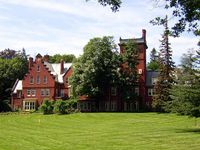Holy Transfiguration Monastery (Brookline, Massachusetts)
Holy Transfiguration Monastery is a men's monastery located in Brookline, Massachusetts, and is the principal monastery of the Holy Orthodox Church in North America (HOCNA), an independent group not in communion with any mainstream Orthodox church. (See the HOCNA page for more detail.)
Foundation
From Mt. Athos to Boston
Fr. Panteleimon, of Greek descent, became a monk on Mt Athos at St. Pantelemon's Monastery. He later joined the New Skete, and with the blessing of Elder Joseph the Hesychast, moved to the Boston area and founded the Holy Transfiguration Monastery.
1960-1970
The monastery was founded in the winter of 1960 in Haverhill, Massachusetts. A modest house was acquired in early 1961 in Jamaica Plain. The house served well until numbers began to grow and more space was needed.
In 1965, Fr Panteleimon and the monastery left the Greek Orthodox Archdiocese of America, accusing it of ecumenism and modernism, and entered the Russian Orthodox Church Outside Russia.
1970-Present
The current location of the Monastery is a 3-Story Mansion, built in 1881 in Brookline, Massachusetts. The adjoining coach house has been converted to cells to accommodate the monks. The Monastery property is mostly wooded, and is about 19 acres. Some land is set aside for the keeping of goats, which provide milk and cheese for the monks.
Amidst various moral accusations, the monastery left ROCOR, accusing it of modernism and ecumenism, and went into various Greek Old Calendarist jurisdictions and, finally, into being the principal monastery for the schismatic Holy Orthodox Church in North America.
Lifestyle
The Monastery follows a cenobitic, or community-style of living, having a population of around 35 monks, including 2 Bishops, 6 priestmonks, and 4 hierodeacons. Only about a third of the monks are of Greek descent, and a significant number of the monks are converts. The Monastery keeps the Julian Calendar (often called "Old Calendar"), and has daily services, which are mostly in English and Greek with some occasional Church Slavonic. Meat is never eaten in the monastery. On most weeks, Monday, Wednesday, and Friday are observed as Fast days, and on these days, fish and dairy products are also not eaten. There are additional obligatory fasting periods, such as the periods of Great Lent, the Apostle's Fast, the Dormition of the Theotokos, and the fast in the honor of the Precious Cross of our Lord (the first two weeks of September).
Daily Schedule
Weekdays: 7:00 AM Breakfast 7:45 AM Working on an Obedience (cooking, translating, making Icons, etc) 12:00 PM (Noon) Common meal 1:00 PM Quiet reflection 3:30 PM 9th Hour and Vespers Common meal after Vespers Working on an Obedience after Common Meal 7:30 PM Small Compline 8:30 PM Monks retire to cells for rest and prayer 12:00 AM (Midnight) Divine Liturgy After Liturgy, Monks retire to cells for rest and prayer
Concerning weekends and Feast Days, quoted from official website: "On Saturdays, Sundays, and Great Feasts, the Divine Liturgy is celebrated at 7:00 a.m., preceded the night before by a Vigil which begins at 6:00 p.m. and ends at 11:00 p.m. or later. On other feast days, Great Vespers with the Blessing of Loaves at 6:00 p.m. may be served instead of the entire vigil, with the Hymns from Matins chanted before the Divine Liturgy the next day."
Visitation
Visitors may attend services and tour the monastery's first floor, workshops, and grounds. With the blessing of the abbot, men may stay overnight, provided some normal restrictions to living in a monastery.
External links
- Official Site
- The HTM Store
- The Holy Orthodox Church of North America, and the Holy Orthodox Metropolis of Boston
- The Holy Orthodox Church in North America
- Sex Scandal at Monastery in Brookline, "The National Herald," November 29, 2012.
